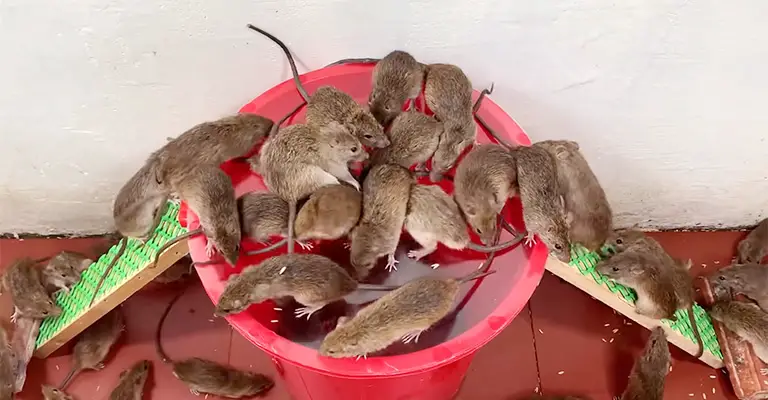Discovering the presence of mice in your home can be an unwelcome surprise, but when they take up residence in the ceiling, the situation becomes particularly challenging.
Mice are agile creatures that can squeeze through tiny openings and make their way into your house’s hidden nooks and crannies.
When they find refuge in the ceiling, their activity can be bothersome, leading to sleepless nights, unexplained scratching sounds, and even damage to your property.
Here are some practical suggestions for getting rid of disease-ridden rodents without damaging your home:
- An array of traps
- Ultrasonic and strobe light repellents
- Peppermint oil
- Plus, other easy remedies
But first, let’s start with the basics:
How Do You Know You Have Mice In The Ceiling?
Do you notice corners missing or nibble holes in cardboard storage boxes?
It is common to see droppings or stains in your attic space as they decay. The older the droppings, the paler they become.
During the night, you might hear scampering, squeaking, and gnawing sounds coming from the ceiling.
In addition to scratch marks on furniture or your walls, you should also look for cracks.
All of these are indicators that you have mice in your ceiling. It is determined by the severity of these indicators and how big the nest will be.
Mice are known to venture off the ceiling at night in search of food, so where else could you find them?
If your infestation is large, It may look like nests are being established in your ceiling or hollow cavities above you.
How To Get Rid Of Mice In The Ceiling With No Access?
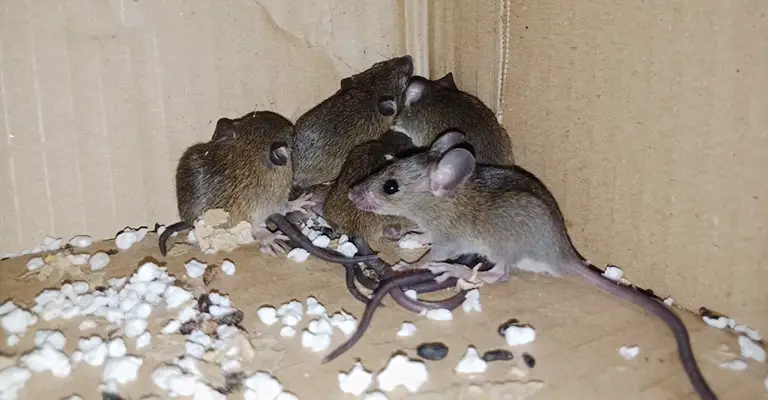
There are times when ceilings are inaccessible:
- Without an attic a ceiling,
- cathedral ceilings,
- a ceiling between floors of a 2-story house,
- an apartment ceiling,
- a finished garage ceiling,
- an RV/trailer ceiling,
- camper,
- and car ceiling
You may have a hard time getting rid of a mouse and its family in some circumstances! Have you been unable to access the space in your ceiling?
Getting started is easy; just follow these steps:
- Locate all entry points to your home, both inside and outside.
- According to a popular myth, mice can squeeze through a hole as small as a dime.
- Ensure these holes are sealed, and traps are placed at their transit points.
You can find out how this is done by reading on! Besides that, ignoring your ceiling’s squeaking won’t help matters. To avoid an uncontrollable plague, you must face this “mice in the ceiling” syndrome head-on.
Some steps must be taken before beginning eradication:
Step 1 — Map It Out
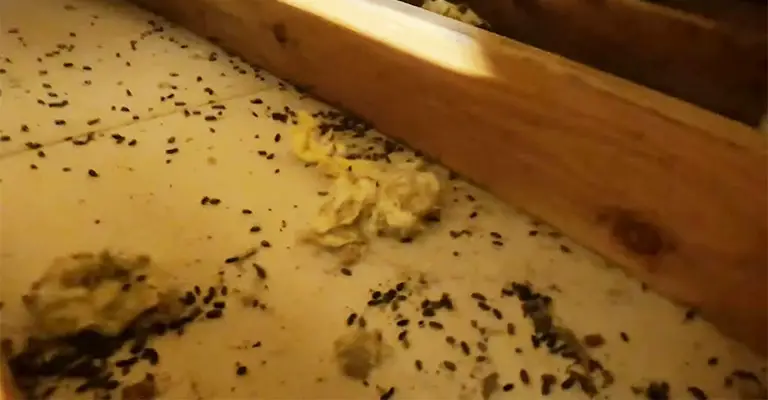
You need to wear long sleeves, gloves, a mask, and goggles in order to check around dark corners inside and around your ceiling space for signs of invasion.
Take a moment to draw a quick map of these places. To find droppings, shredded insulation pieces, and dirt marks along their tracks, you have to look carefully.
You can expect mice to travel to your ceiling using the same pathways every time. Block off entry and commuter points as soon as they have been located. If any holes exist, they can be repaired.
Foam Pest Block Insulating Blocks are ideal for blocking holes, especially in difficult-to-reach areas. The expanding foam will expand upon contact with the holes and seal off the openings.
A steel wool blockage would also be effective since mice cannot eat through metal and can be shaped easily to suit your needs.
Step 2 — Clean It Up
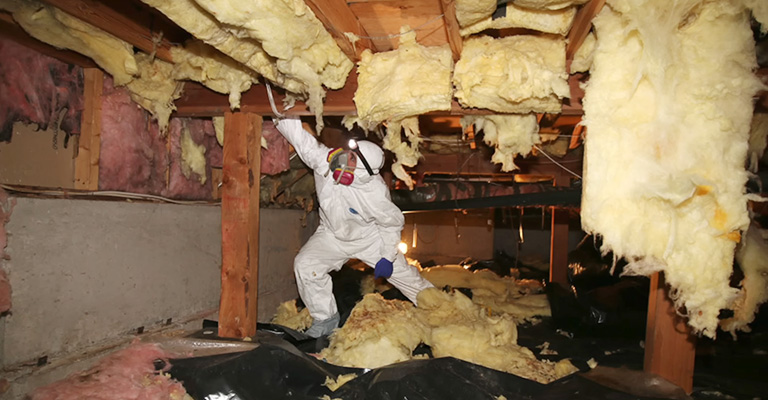
Especially in areas where food is being prepared, clean all surfaces. If there is a food buffet elsewhere in your house, mice looking for shelter and food will be attracted to your ceiling.
The food sources for mice include countertops, food bowls, and crumbs on the floor.
It only takes about one-tenth of an ounce of food each day for mice to live, so removing food sources from your ceiling will move to someone else’s ceiling in search of food.
Tip — Peppermint fragrance will naturally repel mice and keep them away from these surfaces!
Step 3 — Action Time!
In terms of pest control, there are a lot of options, and you must decide which are the right ones for you based on practical experience.
You should consider whether you can kill a rodent from your ceiling and be prepared to dispose of the dead animal.
What About Traps?
Using a mouse trap is the most popular method of catching mice. This might seem like a simple decision, but there are many options:
Tip — Set up traps near the ceiling’s access points. Also, place traps along your map’s tracks.
What is the humane approach you would like to take? A practical method would be to use a “catch and release” trap.
In this way, if you are interested in catching a live mouse, release it at least 5 miles away from your home since mice are territorial and will find their way back to you.
Traps such as snap traps are more traditional. Make bate a part of your nighttime routine by placing them in the ceiling area overnight and changing the location every couple of days.
If the trap catches a mouse’s limb or snout, you’ll need to blow it out immediately with a blow to the head. Ideally, these traps kill the mouse; however, sometimes, they snag its limb and snout.
Tip — Peanut butter is a great bait, but use only a little in your trap if you don’t want the mice to nibble at the bait and leave without being trapped.
The electrical trap costs a little more, but it’s more effective. A battery-powered mouse-killer that operates on batteries, the device is perfect for hard-to-reach ceiling spaces. It dispatches the mouse in a matter of seconds.
In addition to traditional traps, glue traps can also be used. When a mouse passes over the trap, it is glued to the trap, which leaves it starving to death. Their cruelty is unacceptable, and they should not be used.
Poison Kills
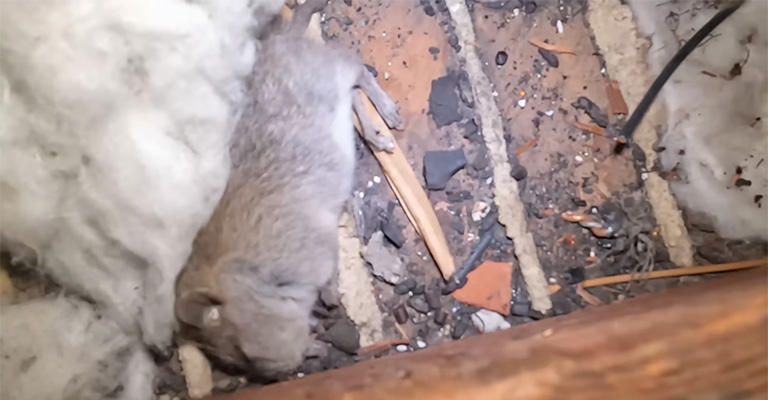
Rodenticides commonly contain anticoagulants, which treat mice internally so that they can bleed to death.
If pets eat poisoned animals or children find the bait, they may become poisoned. The downside of poison is that it has low efficacy when it comes to hard-to-reach areas such as your ceiling.
There are several ways to poison an individual, including:
Pellets:
Placing them in corners, difficult-to-access places, and mice-infested tracks is possible.
Chunks:
Mice can enter roof areas via these holes, so they’re helpful to attach to the wood.
Bait traps:
You can choose between single-use or refillable options, and they are effective because they contain the dead mouse for easy disposal.
When using poison, it is essential to be aware that rotting corpses can be smelly for about 15 days after they die, especially if you live in a humid climate.
Use Rodenticides With Caution
A mouse problem is sometimes solved by poisonous pellets (some mice can be resistant to arsenic or anticoagulant poisons like warfarin), but they do come with a number of consequences.
A mouse or two carries Your pellets back to the nest, and one or more of them die inside. However, in the worst-case scenario, a mouse or two may carry them into your walls and die within.
You might notice something unpleasant in your home several days after the deed is completed.
Can you imagine the worst-case scenario? In addition to rodents, deadly chemicals can poison children and animals.
Place pellets in a tamper-resistant bait station (typically a large black box with one entry and the poison on top) to prevent accidents.
You should go for the station that is closest to the mice’s potential food sources while still being out of reach of domestic animals and children.
Ultrasonic Or Strobe Devices
It is designed to annoy mice so much that they leave immediately. Ultrasonic devices emit ultrasonic frequencies or strobe lighting in an effort to frighten them.
The effect of these products can wear off after a week, as pest controllers advise using them for only a short period of time.
Pets
The presence of a pet cat or dog serves as a repellant; however, I wouldn’t recommend depending on them to eliminate a large plague.
The “guard pets” can’t easily get too high, near your ceiling, to have a substantial impact!
Professional Exterminator
Having tried the DIY tools we suggested and losing the battle, it may be time to seek professional assistance.
It is estimated that professional pest exterminators will cost $150 to $500, depending on the severity of the infestation and the location.
Extra Tips
Taking preventative measures is the key. Ideally, you should prevent mice from becoming interested in your ceiling in the first place. Preventing future infestations requires the following tips:
- Reduce shrubs that brush against your home, and store woodpiles at least 15 feet away. This will prevent the highway from reaching the ceiling.
- Make sure you keep ultrasonic or strobe devices running in your attic or ceiling space.
- Be sure to clean up any food scraps and crumbs you may have in the kitchen: don’t attract them with food.
- Make sure any storage items you store are kept in rigid plastic containers so mice can’t make nests from them.
What Happens If Mice Die In The Ceiling?
About 15 days after the procedure, a lingering smell will persist. In order to achieve odor reduction, the dead mouse must be located, disposed of, and the area sanitized.
If you cannot access it in the ceiling, you can use odor neutralizers such as coffee grounds or an Air Sponge and wait until it goes away.
Can Mice Fall Through The Ceiling?
They might eat through your drywall ceiling if they eat a hole to acquire nesting material.
Can Mice Eat And Chew Through The Ceiling?
They indeed build their nest using any materials available, including drywall, plastic, wood, and plaster.
How Are Mice Getting In My Ceiling?
You can find mice in your home through shrubs that lean up against your eaves and gutters. Additionally, they can be able to gain access through entry points such as air vents and gaps around pipes and gas lines.
How Do You Know If Mice Are Gone?
A lack of fresh mouse droppings is probably the first thing you’ll notice. Ultimately, the signs and destruction that the mice left behind will disappear when they are gone.
You may also notice that when the droppings disappear, the mice won’t come back as often, and you won’t have to clean up the droppings or nests they leave behind.
Final Words
With a few small purchases and a little planning, you can resolve the problem of mice in your ceiling.
It’s first necessary to recognize the signs that you have mice in your ceiling. You simply need to listen and observe and understand what kind of ceiling you have.
Once you have cleaned up well, use traps, poison, or other natural remedies to stop the mice from spreading.
If you follow our DIY plan, you’ll be back on your feet in no time.

